When we arrived in Beijing, Scott was pretty touristed out, and wasn’t that enthusiastic about going to the Great Wall. Becky insisted, and by day three, he was feeling much more excited about the idea. We decided that rather than taking a tour, we would try to get to the wall using public transit. Scott did a lot of reading and research on the Internet about the Mutianyu section of the wall, since this was the section Becky had been to before, and she really enjoyed it. She also remembered that it wasn’t too full of tourists.
We had a plan:
- Take the subway to Dongzhimen metro station, and walk to the Dongzhimen long distance bus station nearby.
- Take bus 916 from Dongzhimen to the town of Huairou, near Mutianyu.
- Stay on the bus until the Huairou terminal, ignoring the taxi drivers who jump on the bus part way, and tell you their taxi is the only way to get to the wall.
- Find the nearby bus stop for the smaller bus to Mutianyu.
Our plan lasted until step 1, the Dongzhimen metro station. As we were looking around for the signs to the long distance bus station, and a friendly English-speaking Chinese lady decided to help us. She pointed us in the direction of the bus station (where she was going too), then when we said we were planning to go to Mutianyu, said “No, No, Mutianyu very small, Simatai very big!” After a bit more convincing, we threw our carefully researched plans to the wind, and hopped on the 980 bus toward Simatai.
Once we got on the bus, our trusty Lonely Planet Beijing guidebook told us the 980 bus only went about half way, and we needed to take a minibus or taxi the remaining 70 km. The bus attendant told us to get off at Miyun, as we expected, but when we looked around, there was no minibus (or bus station) in sight. Instead there were several taxi drivers surrounding us like vultures…
To stall for time, we asked about a toilet, and the “lead” driver pointed us at some nearby bushes. We went and did our business, and quickly discussed our tactics. We wanted to try to find the minibus station, but knew we couldn’t get away from the taxi drivers without some negotiation. Unfortunately, the driver came to join us, notebook in hand, before we had time to agree on a top price. Scott decided our top price would be 150 RMB (about $30 CAD, and a bit more than the 2007 Lonely Planet listed as typical). The driver started at 250 RMB one way, or 400 RMB round trip, so we figured this wasn’t going to go very far. After a bit of back and forth, Scott said 150 RMB was his top price, and asked where the 980 bus back to Beijing stopped. As we started walking there, the prices dropped dramatically. First 250, then 200, then finally 150 RMB. At this point we were fed up, with no minibus in sight, and no information where it might stop. We were about ready to give up on our Great Wall goal for the day (and this trip), since part of the fun was to get there by public transit. Unfortunately, when the driver reached 150 RMB, Becky felt honour-bound to accept. Another change in plans!
We got in the taxi, and started driving toward Simatai, when the driver received a phone call. Around we turned, and returned to near the bus stop. Another 980 bus was there, and several white-looking bodies were piling out. Another car pulled up, and our driver unceremoniously ushered us into it, and roared off to meet the new bus. We guess he was the driver with the best English or best negotiating skills, and was needed with this new group.
Our new driver spoke absolutely no English, and Scott’s attempts at Mandarin were met with either bafflement or rapidfire Chinese which we couldn’t understand. After a few attempts, we chatted between ourselves, and looked at the (admittedly spectacular) scenery. After 90 minutes or so, we could see the Great Wall. It did look impressive, but we weren’t there yet. Our driver mimed hunger and food, and when we agreed we were hungry (reasonably so, since it was just after noon), he pulled over, and brought us into a restaurant. We sat, and were presented with a menu. Great! It has English! At second glance, it also had the highest prices we’ve seen in months, with entrees at 50 to 80 RMB, instead of 5 to 15! We quickly picked two of the cheapest things on the menu, order drinks and wait. Another woman came out, pulls the driver over, and tried to convince us that we want the expensive stuff. We used our handy phrase book to indicate stomach distress (which was at least slightly true), and stuck with our bland order of noodle soup and plain rice, which turned out to be quite delicious.
After all this buildup, a few minutes after lunch, we were at the Great Wall. Now our driver wanted partial payment for our trip. At first he asked for 100 RMB then 50 RMB later, but we finally agreed on 80 RMB, and 70 RMB later.
The wall looked spectacular from the ticket office, and we decided to take the Cable Car up, rather than walking. It turned out to be 30 minutes on the worlds slowest cable car (a re-purposed ski lift), but it did give us some nice views, and got us to the top both faster and with more energy for the wall itself. At the top, Becky decided to take the Funicular up the next steep stretch, but Scott wanted to walk. It turned out to be 15 minute either way, although Becky did get to the top first.
This left us about 10 meters below the wall, so we started to climb. Within a few minutes, we had picked up a friendly guide – an English speaking woman who started to follow us and chat. Could this be another good Samaritan? No, as it turned out. Although she was very friendly, she was clearly most interested in selling us souvenirs. Once Scott foolishly said we would buy something on the way down, she became inseparable. No complaints though – she gave us a guided tour of the wall, and chatted with us about life as a farmer in Northern China. She has two children, which was apparently permitted because the first was a daughter. Perhaps a way around the female infanticide problems caused by China’s “One Child” policy?
We could not have asked for a better day for our climb on the wall. Beautiful blue sky with no haze, a light wind, and comfortably warm temperature. Absolutely perfect. We took a pile of photos, and Scott was very happy with his. Becky was complaining about the colour of hers, and wondering if her screen was going. Finally, Scott asked if she wanted him to look at it, and did. It was set for indoor (Tungsten) white balance, instead of the Automatic White Balance she normally uses. Scott had switched it to take some dinner photos two nights before. Whups! Anyone know a good way to correct the White Balance on JPEG files? (We did try with a few of the photos from Olympic Park, but the results were not outstanding.)
The wall itself was spectacular, seeming to go on forever, climbing over knife-edge peaks. We wouldn’t want to have been building it! There were a few flat stretches, but in many cases the wall climbed steeply, following the ridge-line. There were battlements so we could walk along the wall most of the time, but in a few places we had to hide behind the wall instead.
Becky remembers the awe she felt the first time she visited the wall, ten years ago at Mutianyu, but didn’t feel the same awe this time. Scott was pretty impressed though. Her knee started bothering her after the first two hours, so it’s good we didn’t do anything more strenuous.
As we were contemplating the long walk down to the parking lot, we came across someone selling tickets for a zip line. The zip line would take us all the way down to the river where a boat would take us back to the parking lot – all for 40 RMB each ($8 CAD). With Becky’s knee acting up, this was an ideal way to get down – and a lot of fun too! On the boat, we met Ann from Holland (although we didn’t know her then). At this point, it was already 30 minutes after the time we had agreed to meet our driver, so we hurried back.
Our driver was waiting for us, and we hopped in and both quickly fell asleep. Our typical reaction to car rides, but it may have caused our driver some anxiety. With us sleeping most of the way back, we were a bit disoriented when he said we were here, at a different spot than he’d picked us up. After a bit of mimed communication, we figured out we were around the corner from the Bus Terminal. We walked the 100m to the station, and got on a 980 bus about to leave. Here we met Ann again – she had a taxi of her own, and had beaten us by a couple of minutes. We got to talking, and invited her to join us for Peking Duck, since more people allows for more choices.
We arrived back in Dongzhimen, and agreed on a restaurant.
Unfortunately, we felt quite ripped off by the Quanjude Roast Duck Restaurant (on Wangfujing Dajie) – we ordered a half duck, expecting the full treatment – skin course, pancake course, stir-fry course, soup course. Instead we got only a small amount of skin and meat (most of the meat was still on the carcass). We separately ordered some pancakes, so were able to make the duck wraps, but it seemed very expensive for what it was. Being frugal about our choices and leaving a still a little hungry, 330 RMB ($66 CAD) for 3 people is a bit excessive! If we’d gotten all 4 courses and actually received the meat from half the duck, the price would be have justified.
Anyway, the company made up for it. Ann and Becky chatted constantly, which should give Becky her “people” fix for the next few days. Ann is interesting – she just finished her undergrad in Health and Public Policy, and is planning to go back for a Masters in Urban Planning so she can design and build healthy communities. Interesting career plan! She has been in China for 3 months, on an ISIC grant working on HIV/AIDS in Shanghai, but that’s now finished, so she is touring around China for a bit, then heading to Vietnam shortly to meet up with a friend. Scott remembers looking into ISIC when he was in university, but doesn’t remember any opportunities which were that interesting.
We talked about how to eat better when we get back to Canada, and one idea is to make and eat lunch ourselves, making sure to stop for at least 30 minutes, and to ensure we eat something as soon as we get off the bikes. We have found that when we eat in restaurants, it’s difficult to get a good nutrient balance, but when we pack lunches, we never really stop. Scott suggested that we plan to record what we’re eating and how we’re feeling, so we can get a better idea of what works and what doesn’t. We’ll see if we can manage that!
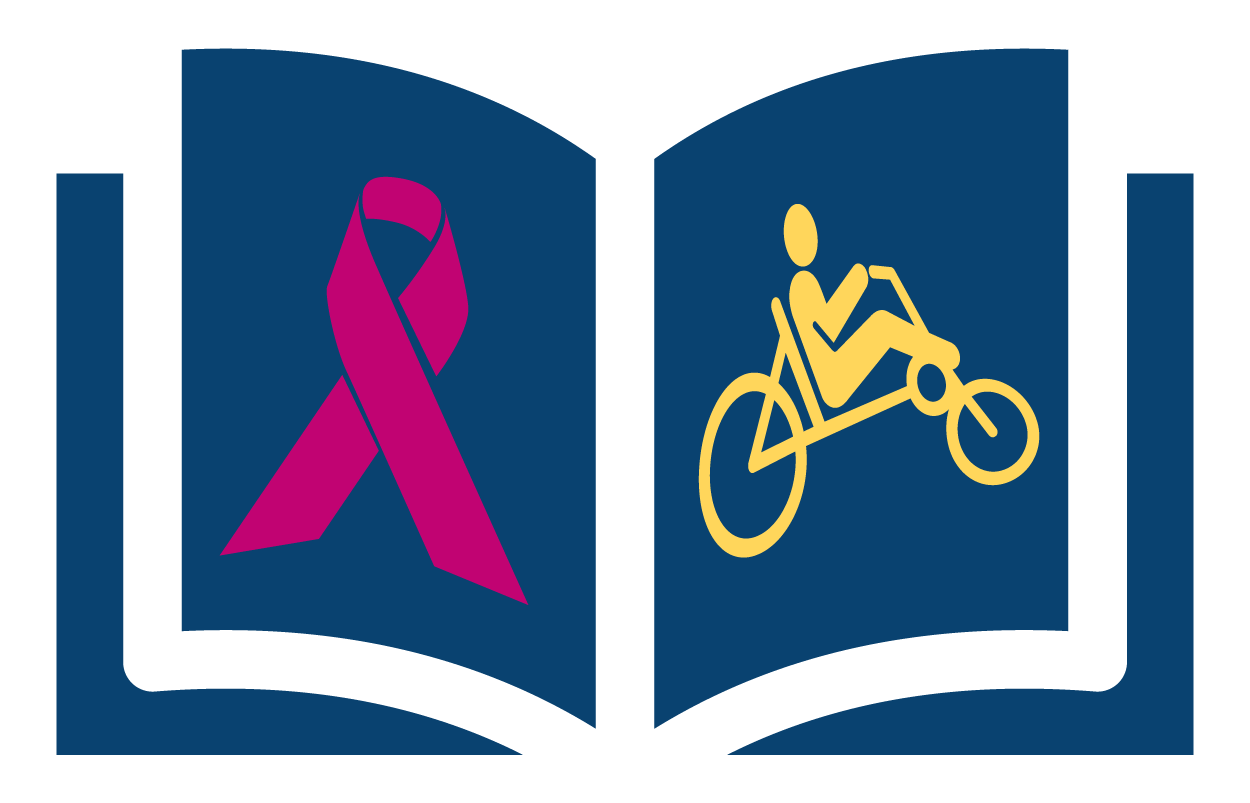
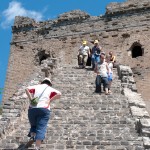


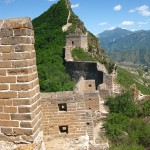
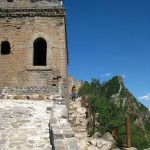
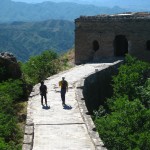

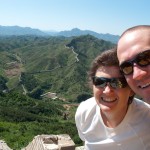
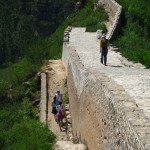

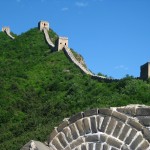
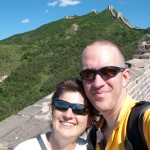
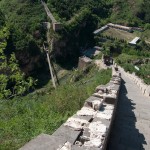
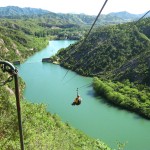
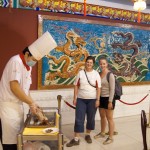
Leave a Reply